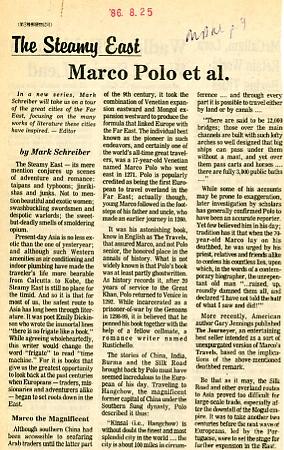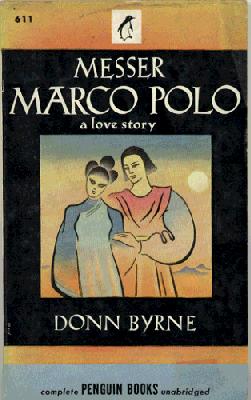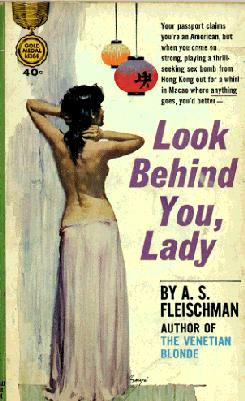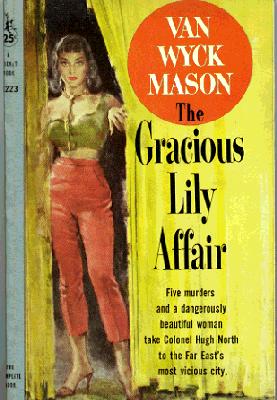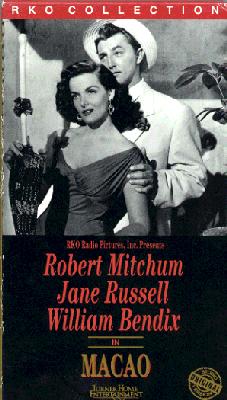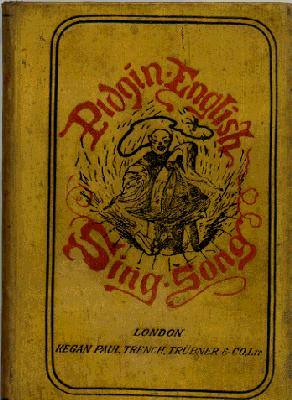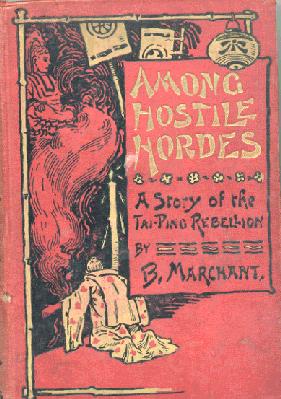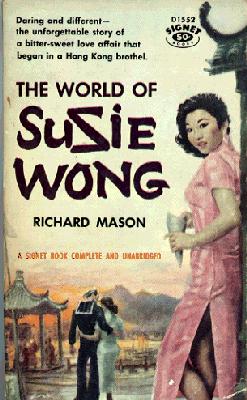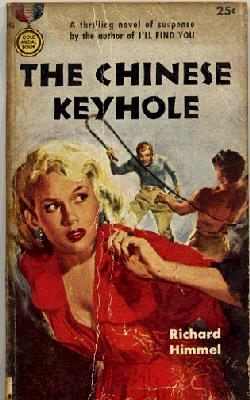The Steamy East
Mark Schreiber's Mainichi Daily News column
By William Wetherall
First posted circa 1995
Last updated 7 August 2024
The Steamy East (1) Marco Polo et al • (2) Onward to Macao • (3) The China Seas • (4) The "Fragrant Port" • (5) Suez to Suzie Wong • (6) 11 years to 1997
Mark Schreiber, 1986-1988The Steamy EastMainichi Daily News, Monday ArtsThe articles featured here are from "The Steamy East", a weekly newspaper column by Mark Schreiber, which ran for two years on the Monday Arts page of the Mainichi Daily News. The first of dozens of installments appeared on 25 August 1986, and the last came out on 26 September 1988. The articles, which examine topics more than review stories, took readers on fictional tours of the great cities of the Far East -- as not a few Eurocentric novelists still refer to China, Korea, and Japan in tales inspired by their understandings or images of these remote centers of steamy Oriental life. Today the Orient is more intimately called Asia, and its easternmost region is more commonly described in Asiacentric geographies as East Asia. Your guide, Mark Schreiber, is a voracious collector and reader of English fiction set in Asia, and a veteran reviewer of such fiction and commentator on especially crime stories. Schreiber warmed up to "The Steamy East" column with a shorter series titled "Beyond the Yellow Peril", which ran on the Monday Arts page of Mainichi Daily News from 16 July through 8 October 1984, and with a mini-series of four variously titled articles that ran on the same page from 23 December 1985 through 13 January 1986. While introducing stories related to their themes, the columns gush with trivia related to the authors, the settings, and the times. They are written in a breezy entertaining style, which eschews the sort of "critical" analysis and argot favored by the post-modernists who populate university literature departments, for whom Steamy East fiction is mostly fodder for their studies of racist and sexist images and stereotypes. William Wetherall |
The Steamy East (1)Marco Polo et alBy Mark SchreiberMainichi Daily News Messer Marco Polo, by Donn Byrne, was first published in 1921. The cover is from the first Penguin Books edition of 1946. The Steamy East -- its mere mention conjures up scenes of adventure and romance: taipans and typhoons; jinrikishas and junks. Not to mention beautiful and exotic women; swashbuckling swordsmen and despotic warlords; the sweet-but-deadly smells of smoldering opium. Present-day Asia is no less exotic than the one of yesteryear. And although such amenities as air conditioning indoor plumbing have made the traveler's life more bearable from Calcutta to Kobe, the Steamy East is still no place for the timid. And so it is that for most of us, the safest route to Asia has long been through literature. It was poet Emily Dickinson who wrote the immortal lines "there is no frigate like a book." While agreeing wholeheartedly, this writer would change the word "frigate" to read "time machine." For it is books that give us the greatest opportunity to look back at the past centuries when Europeans -- traders, missionaries and adventurers alike -- began to set roots down in the East. Marco the MagnificentAlthough southern China had been accessible to seafaring Arab traders until the latter part of the 9th century, it took the combination of Venetian expansion eastward and Mongol expansion westward to produce the formula that linked Europe with the Far East. The individual best known as the pioneer in such endeavors, and certainly one of the world's all-time great travelers, was a 17-year-old Venetian named Marco Polo who went east in 1271. Polo is popularly credited as being the first European to travel overland in the Far East; actually though, young Marco followed in the footsteps of his father and uncle, who made an earlier journey in 1260. It was his astonishing book, know in English as The Travels, that assured Marco, and not Polo senior, the honored place in the annals of history. What is not widely known is that Polo's book was at least partly ghostwritten. As history records it, after 20 years of service to the Great Khan, Polo returned to Venice in 1292. While incarcerated as a prisoner of war by the Genoans in 1298-99, it is believed that he penned his book together with the help of a fellow cellmate, a romance writer named Rustichello. The stories of China, India, Burma and the Silk Road brought back by Polo must have seemed incredulous to Europeans of those times. Traveling to Hangchow, the magnificent former capital of China under the Southern Sung dynasty, Polo described it. thus: "Kinsai (i.e., Hangchow) is without doubt the finest and most splendid city in the world . . . . the city is about 100 miles in circumference . . . and through every part it is possible to travel either by land or by canals . . . . "There are said to be 12,000 bridges; those over the main channels are built with such lofty arches so well designed that big ships can pass under them without a mast, and yet over them pass carts and horses . . . there are fully 3,000 public baths . . . ." Tradition has it that when the 70 year-old Marco lay on his deathbed, he was urged by his priest, relatives and friends alike to confess his countless lies, upon which, in the words of a contemporary biographer, the unrepentant old man "raised up, roundly damned them all, and declared, "I have not told the half of what I saw and did!"' More recently, American author Gary Jennings published "The Journeyer," an entertaining best seller intended as a sort of unexpurgated version of Marco's Travels, based on the implications of the above mentioned deathbed remark. Be that as it may, the Silk Road and other overland routes to Asia proved too difficult for large-scale trade, especially after the downfall of the Mogul empire. It was to take another two centuries before the next wave of Europeans, led by the Portuguese, were to set the stage for further expansion in the East. |
The Steamy East (2)Onward to MacaoBy Mark SchreiberMainichi Daily News A.S. Fleischman's Look Behind You, Lady, set in Hong Kong and Macao, was first published in 1952. This is the third printing, 1963. The seafaring Portuguese were the first to round the Cape of Good Hope in 1488, and pressed eastward to the Indian Ocean. Vasco da Gama's arrival in 1498 set the stage for colonization of areas on the west coast of India. The Portuguese defeated an Arab fleet in 1509, after which their next stop was to capture Goa, an Indian port south of Bombay, in 1510. Only a year later, they occupied Malacca, the port which controls the straits between Sumatra and the Malay peninsula. Once the Malacca Straits were breached, China was only a few week's sail away. First to reach' it was a sea captain named Rapahael Perestrello, who in 1515 sailed as far as the islands at the mouth of the Canton River - the first time for a European vessel to reach the coast of China. Within seven years, another Portuguese, Simon de Andrade, attempted to establish sovereignty over Chinese territory at San-shan, near present-day Macao, and a military engagement ensued. Only shortly afterwards, the Chinese provoked a quarrel with another expedition from Portugal, resulting in a near massacre of the foreign visitors. |
|
From first edition of Van Wyck Mason's The Gracious Lily Affair, a Macao potboiler, dated November 1958. Meanwhile, Spaniard Ferdinand Magellan became the first explorer to circumnavigate the globe, in a voyage lasting from 1519 to 1522. (Only one of the five ships of the expedition returned to port, however, and Magellan himself was killed in battle with the natives near Cebu, Philippines, in April 1521 - but not without first claiming title to that chain of islands for Spain. The first and most durable of the early European elements in the Far East was Macao, Cidade do Nome de Deos na China, the City of the Name of God in China, a sleepy six square mile enclave at the end of a narrow peninsula on the Canton River. About 35 miles from Hong Kong, it has a present-day population of over 300,000 Although 1557 is the year given to the founding of Macao, circumstances behind the colony's true origins are obscure. One story has it that in 1535, the Portuguese obtained the permission of Chinese officials to erect some sheds for drying some goods damaged in a storm. The sheds endured, although for the first two or three decades little attention was paid to the colony. Another version has it that the Portuguese first gained the goodwill, of their Chinese hosts by driving off, a band of pirates which had plagued the area. The city took its name from A-macao, a nearby temple on the peninsula dedicated to A-ma of Ma-Tzu, the Chinese goddess of the sea. Annual rents were paid to the Chinese government until the communist takeover in 1949. Like its larger neighbor Hong Kong, Macao's eventual reversion to China is likely to take place by the end of the century. |
|
The 1952 RKO noir drama Macao promised moviegoers "steamy passion" in a setting of "international intrigue." Robert Mitchum gives one of his better performances. Copyright 1992, Turner Home Entertainment. In addition to being the sole outpost of trade for several centuries, Macao served as the gateway to China for European Jesuit scholars, of whom a number, such as Veribest, Schall and Mateo Ricci, were admitted to disseminate their considerable knowledge of astronomy and mathematics at the capital, Peking. The novel Manchu by China watcher Robert Elegant is one such story, an account of the adventures of Francis Arrowsmith, a young English Jesuit and soldier-of-fortune at the Chinese imperial court. The novel covers the tumultuous declining years of the Ming Dynasty up to China's 1644 takeover by the Manchus. Also of interest is City of Broken Promises (1957) by Austin Coates. The book, which takes place in the 1780s, is a fictionalized account of the life of Martha Merop, an orphan who was sold into prostitution at 13 and who prevailed to become a female taipan and Macao's greatest. public benefactress. Daniel Carney's 1985 novel Macau gives a more contemporary look at the colony. The story of a Chinese female gang leader attempting to smuggle a fortune of gold into Hong Kong by ship, Macau is a stirring tale of modern-day piracy that pits rival Chinese gangs against each other and the British. The 1986 spy thriller The Bourne Supremacy, by Robert Ludlum, also features some heavy action in Macao's gambling casinos And back alleyways. It did not take the Manchus long after gaining control of China in the mid-1640s to realize that the ever-increasing arrivals of foreign barbarians were more trouble than they were worth; as such, Macao remained the sole foreign outpost for trade with China. Meanwhile, aggressive Dutch and English privateers roamed the China seas, waiting for the events, not long in coming, which would redraw the map of Asia once again. |
The Steamy East (3)The China SeasBy Mark SchreiberMainichi Daily News Port pidgin language actually became something of an art form. Pidgin English Sing Song, by Charles G. Leland, an author famed for his dialect humor, was published in London in 1910 [sic = 1876]. "Although the Portuguese were the first to set up a permanent colony in East Asia, their supremacy was to be short-lived. The Dutch, bitter enemies of Spain (and of Portugal as well, which was annexed by the Spanish from 1581 to 1640), launched a major expedition to Java in 1595, and the English were to follow with their own expedition a year later. The first English ships to the East carried with them a letter of introduction to the Emperor of China from Queen Elizabeth 1. Unfortunately, no one knows what became of those three English ships, except that they vanished without a trace. "Distraught at the prospect of losing prospective Asian markets to the Dutch, a group of London merchants petitioned the crown for assistance. This resulted in the 15-year charter of "The Governor and Company of Merchants of London trading into the East Indies." Better known as the East India Company, it received a new perpetual trading monopoly from King James I in 1609, after which it embarked on a course which was to change history. "The 1630s to the 1840s were the golden era of the China Traders, as English, Dutch, Portuguese and Spanish sailed up and down the China coast, often ignoring Chinese restrictions on trade as they exchanged their various goods for tea, silks and rhubarb, the latter much in demand as a purgative. Amoy, Fujian Province, was one of the major trade centers; other ships sought goods at the ports of Swatow, Ningpo and across the straits in Taiwan. "But the center for large-scale trade remained Canton, where the Peking government assigned a hoppo (trade commissioner) and allowed the "fan qui" (foreign barbarians) to set up "factories," which were really basically warehouses, in an isolated area of Canton City. Western women were forbidden, and family men had to leave their wives and children in nearby Macao during the trading season "As Chinese were prohibited to teach their language to foreigners, the co-hongs (Chinese merchant traders), Western sailors and traders worked out a lingua franca known as pidgin, a mixture of English, Portuguese and Chinese that came to be the language of business (the word "pidgin" itself is derived from the English word "business") throughout Eastern ports. "Pidgin, nearly extinct today except for a variety spoken in Papua-New Guinea, is a fascinating tongue, and many samples of instructions on its usage can be found in travel guidebooks published before World War II. "Get me a rickshaw" is "Catchee my one piece rickshaw;" while "Tell the cook to prepare dinner for three today" is "talkee cook three piecee man dinner." Pidgin words easily still recognized today include "joss" (luck); "kumshaw" (a tip or bribe); "chop-chop" (at once); "godown" (a warehouse); and the catch-all term when things never, seem to go right - "maskee" (never mind, forget it). "A number of novels concentrate on the exciting - and often perilous - life of a sea trader on the China Coast. One of the earliest examples to this reporter's knowledge is a curious old book, my copy of which is undated, entitled "A Cruise In Chinese Waters, Being the log of "The Fortuna." This book, whose contents suggest it was written about the time of the Taiping Rebellion (mid-19th century) represents one of a select number of old novels about the adventuresome seamen who plied the waters off the coast of China. As one story by Captain Augustus F. Lindley begins, "My Queen Mary was a smart little lorcha of one hundred tons burden, and shortly before the great river, the... Yangtse Kiang, was opened to foreigners by the jealous Government of China, I was foolish enough to venture on a trading trip up its almost unknown, and comparatively unexplored waters .... "Several other books introduce the days on the China coast in the years just prior to the Opium War. English author James Leasor's 1973 novel Mandarin Gold is the story of one Robert Gunn, a young ship's doctor who prevails over some forn-ddable rivals to establish the Mandarin-Gold trading company in 1833. Further accounts of Dr. Gunn's adventures followed in Leasor's sequels, The Chinese Widow (1975) and Jade Gate (1976). "Many of the merchants were aware of what the drug opium did to its users and for moral reasons eventually came to oppose its sale. E.V. Thompson's 1981 novel The Dream Traders is about one such man, Luke Trewarne, a Cornish trader who fell in love with the beautiful daughter of a hoklo, a Chinese water gypsy. "The China Coast remained hazardous long after the founding of the colony of Hong Kong and other concessions at other treaty ports from the 1840s onward. Piracy - kidnapping, robbery and murder - was rampant. Those wishing to read of true accounts of Chinese piracy - which extended well into the present century - will find a 1932 work of nonfiction, Vampires on the China Coast that amply demonstrates the hazards risked by the old-time seagoing traveler. |
The Steamy East (4)The "Fragrant Port"By Mark SchreiberMainichi Daily News Around 1901, Bessie Marchant, a prolific British author of children's fiction, penned Among Hostile Hordes, a Chinese historical adventure set during the Taiping Rebellion. Although the East India Company was licensed in 1609 by the British crown to trade as a monopoly in the Far East, the only Europeans to meet with any initial success were the Portuguese in the south and the Russians in the north; it was not until 1699 that the first English ship was allowed to trade at Canton. The opening up of Canton for large-scale trade to ships of all nations came after two centuries of delaying action on the part of Chinese. Nevertheless, restrictions abounded: Foreign "factories" (warehouses) were confined to a small ghetto outside the city walls, where they made their purchases, of tea, silk cloth, ginger, sugar, rhubarb and other items. While business was profitable, Life was indeed hard in those times. Luxuries were few, with such maladies as scurvy and dysentery a constant threat. The notion of "non-tariff barriers" may indeed be a Chinese invention, for in addition to complex red tape, and customs duties for the. exchange of goods, Chinese officials demanded their "squeeze" - bribe - for virtually every type of transaction. As a way of reducing their trade deficit, foreign merchants found a ready market in China for India-grown opium. Indeed, the drug became such a problem that in 1729 it was banned by imperial edict; but the combination of rampant smuggling and official corruption failed to blunt its spread. While foreign privateers sailed up and down its coast in increasing numbers, China, the "Central Flowery Kingdom," remained blissfully unconcerned with the state of the world beyond its borders. The British, who had established their supremacy on the seas, began to get just a wee bit impatient over the arrogance shown by the Imperial Chinese government. The first British mission journeyed to Peking in 1793, "bearing gifts for the Emperor of China from the King of Great Britain." Unimpressed, the aging Emperor Ch'ien Lung replied thus to King George III: Now you, 0 King, have presented various objects to the throne, and mindful of your loyalty we have specially ordered our Ministry to receive them. Nevertheless, we have never valued ingenious articles, nor do we have the slightest need of your Country's manufacture... After a change of emperors, Lord Amherst tried again 23 years later, only to be turned away more abruptly, with "Your presents are of no interest or use. In the future, do not bother to dispatch them." Needless to, say, the British found this attitude infuriating, and things started getting nasty - especially when the Chime adopted draconian measures to deal with the opium problem. By 1838, imports of the drug had quadrupled from only a decade before, and the confiscations, burnings and arrests escalated into a military conflict that culminated in the first Opium War in 1839. Victorious, the British won access to Shanghai, Ningpo, Amoy and two other "Treaty Ports," as well as perpetual title to a rocky, 30-square-mile island, 80 miles from Canton: Hong Kong. The British took title on January 25, 1841. Not everyone back in England found the victory over the Chinese an occasion for celebration. In Parliament, William Gladstone, who was later to become prime minister, expressed, his outrage at the actions of the navy: " ... now the (British) flag is hoisted to protect an infamous contraband traffic, and if it were never to be hoisted, except as it is now ... on the coast of China, we should recoil from its sight with horror..." Once they had their own colony, the next step by the British was to declare Hong Kong a free port; Chinese merchants from neighboring provinces flocked to the new British territory if for no other reason than to escape from the corruption rampant in their own country. Foreign trading firms headed by partners or managers - called taipans - and their assistants - the griffins - engaged in spirited competitions. Most of these oldtime taipans were rarely over thirty years old. Probably the most exhaustive historical work on the circum stances that led to the founding of Hong Kong is J. B. Eames) The English in China, a massive book first published in 1909 and reprinted in 1974. In fiction, James Clavell's 1966 novel Taipan stands as the definitive work on Hong Kong's early years, and as such must be regarded as compulsory reading. The story begins Jan. 26, 1841 - the day after the founding of the colony. The Taipan is Dirk Struan, a Scottish sea captain and opium trader who struggles against cutthroat business rivals, members of his own family, Chinese pirates and Mother Nature to found a great commercial dynasty - Struan and Company, also known as the Noble House. Like Shogun, Clavell's other bestseller, Taipan, also overflows with a tragic romance, in this case between Struan and a beautiful Chinese concubine, May-may. A blockbuster adventure story with a cliff-hanger ending to every chapter, it is due to make its Hollywood premiere in a matter of months, and I for one look forward with interest to see how this unforgettable tale of Hong Kong's early days makes the transition to the silver screen. |
The Steamy East (5)Suez to Suzie WongBy Mark SchreiberMainichi Daily News The cover of Signet's 1958 first-edition paperback of Richard Mason's The World of Suzie Wong. It may seem hard to believe, but at the time of its release interracial love was still considered highly controversial [in some quarters -- and, in some quarters, still is]. Essential factors in Hong Kong's development were the trading houses, banks and other institutions which have survived to this day. The establishment of the Hongkong and Shanghai Bank in 1864 proved a boon to traders, who, lacking a source of credit, bad previously had to tie up their money and goods for a year or longer while the ships made the round trip between London and the Far East. As George Woodcock related in his 1969 history, The British in the Far East, a major factor in Hong Kong's growth was the opening in 1869 of the Suez Canal to steamships, which reduced the journey of a sea passage from London to Singapore from an uncomfortable six months to just 42 days. Telegraph service to London was begun in 1870, further shortening the lines of communication with the mother country. While the few tens of dozens of Europeans and Americans began their long journeys to the East, Hong Kong meanwhile was also the point of emigration for hundreds of thousands of Chinese peasants. These emigrants, mostly Hakkas (a hill tribe) and Cantonese, left their impoverished homes to seek work in the rubber plantations of Southeast Asia, the wharves of London and at railroads and mine fields in the American West. Before the end of this series, I hope to describe what life was like in these overseas "Chinatowns." By the turn of the century, Hong Kong had become an established stopover for tourists. An early guidebook described the colony around 1920, by which time its population had grown to nearly half a million. There are grander sights to be seen in the world, but few more picturesque and graceful than that of Hong Kong...suddenly your vessel makes a curve and the narrow channel discloses a fleet of ships, junks and sampans; the extended curve of quays; the regular line of buildings, and above them, rising on a succession of hill slopes, the villas in tiers along the zigzags of the mountain roads . . . . It is hard to put any specific date on when Hong Kong became the setting of adventure novels, but there are at least a few which predate World War II. One of these is The Hongkong Airbase Murders by F. van Wyck Mason, who penned a popular series of Far Eastern thrillers in the 1930s. There are also a number of more recent thrillers about the war years in Hong Kong, such as Bastion (1980), Anthony Esler's saga of the months just before and after the outbreak of hostilities in 1941. China Gold (1982), by John Tarrant, sees an American crook plan to heist the colony's gold reserves under the noses of the advancing Japanese army. Before Hong Kong became the concrete jungle that it is today, for years it was, beyond the border of the New Territories, quite pastoral. Certainly, one of the most charming biographies that I have encountered is Myself a Mandarin (1968) by Austin Coates, which gives a highly humorous account of a colonial magistrate assigned to preside over claims and disputes in a rural court in the New Territories. It was later made into a film. By the 1950s, if books and films are any indication, the images presented by Hong Kong had become rather sentimental. Stories get in the colony inspired at least two famous film romances. A Many-Splendored Thing is Belgian-Chinese author Han Suyin's semi-autobiographical story about the love of a beautiful Chinese doctor for a war correspondent. The 1955 film starred Jennifer Jones -- made up to appear Eurasian -- and William Holden. In 1957, the appearance of Richard Mason's The World of Suzie Wong created something of a stir. The Shanghainese bar girl with a heart of gold (or any other negotiable currency), Suzie makes the acquaintance of an aspiring British artist Robert Lomax (played respectively by Nancy Kwan and William Holden in the 1960 film), who has transformed a cheap Waichai hotel room into his art studio. After years of entertaining sailors on the waterfront, Suzie is fascinated to meet a Westerner with any sense of culture or refinement. Lomax's problem is that he likes Suzie too, but can barely make ends meet as it is. An excerpt: "I'd work for you very cheap. One month -- six hundred dollars. Never go with other boyfriends." "Suzie, I'll tell you the truth. I'm not really a big man at all. I'm terribly poor -- I've only got six hundred dollars a month to live on altogether." "That's all? For room? Chow? Everything?" "Everything." "Then no good." |
The Steamy East (6)11 years to 1997By Mark SchreiberMainichi Daily News In the blurb on the back cover of The Chinese Keyhole, published in 1951, the American protagonist smashes his way "through a mess of murder, mayhem, lust and sadism to the Chinese Keyhole, where hell was set to music." Since the 1950s and 60s, when the professional "China watchers" began gathering in Hong Kong to observe the goings-on behind the Bamboo Curtain, the colony has increasingly become the setting for novels --- and films --- of excitement, mystery and suspense. Novels of note with Hong Kong In the title include A Coffin from Hong Kong (1962) by James Hadley Chase, Mignon G. Eberhart's 1968 mystery thriller Message from Hong Kong and more recently, Dorothy Gilman's middle aged female CIA operative Mrs. Pollifax, who makes another appearance in Mm. Pollifax and the Hong Kong Buddha 1985). (The story, about an attempt by die-hard Chinese Nationalists on Taiwan to thwart the British Chinese agreement, was echoed in Robert Ludlum's still current bestseller, The Bourne Supremacy.) The legacy of piracy and smuggling on the China Seas continues in Hong Kong even today. A major source of crime is an underground organization known as the Triads. Often referred to as the Chinese Mafia, they are direct descendants of such secret organizations as the White Lotus Society, founded in the 12th century, whose purpose was to resist foreign domination and restore Chinese rule. In modern times, these groups have been transplanted overseas as well, and Chinese Nationalist leaders Sun Yat-sen and Chiang Kai-shek were said to have been among the members. Not all triad organizations were engaged in criminal activities, but their insistence on secrecy makes them suspect by law enforcement authorities. New members are brought in with mystical initiation rituals, at which they must pledge never to betray the organization on pain of death by "a myriad of swords --- a term which is usually given in English as the in excruciating "Death of a Thousand Cuts." There are numerous novels involving the activities of the Hong Kong triads, including a gang called the Black Phoenix in The Kung Fu Avengers (1975). Others include The Chinese Consortium by Wolf Rilla (1979) and Terror of the Triads by Sean O'Callaaghan (1982) Hong Kong is the location for numerous adventure stories and spy thrillers. Hooligan (1968) by David Dodge, is the story of a U.S. Treasury agent sent to assassinate, a Hong Kong financier who is draining the U.S. Treasury by sending too many dollars to Beijing. Pangolin (1979), another recommended thriller, is about an attempt to kidnap and hold the top U.S. intelligence officer in the Far East for ransom. In terms of unusual titles, my personal favorite is a 1974 paperback by Terry Harknett entitled The Sweet and Sour Kill. It should also be noted that the crown colony has also long served as an exit point from China. Books involving daring escapes over the Chinese border include Secret: Hong Kong (1962), The Deadly Eurasian (1967) and The Confucius Enigma (1982) by Margaret Jones. Billed as a tale of takeovers, mergers, wheeling and dealing with millions while staving off bankruptcy, James Clavell's Noble House (1981), which takes place in Hong Kong between 1960 and 1963, is a prime example of entrepreneurial one upmanship, and represents a continuation of his epic novel Taipan. The Years of the Hungry Tiger (1974) by John Gordon Davis, is notable for its portrayal of the city during Mao's tumultuous Cultural Revolution in 1966. The year 1977 had not one but two blockbuster novels situated in Hong Kong: Robert Elegant's bestseller Dynasty ties in the colony's history with the remarkable Sekloongs, tracing the family from, its Irish Chinese ancestral roots back in the 1850s, and bringing the history up to the 1970s. John Le Carre's The Honorable Schoolboy, by England's master of spy fiction, centers around Soviet intelligence operations in the Far East at the time of the collapse of Vietnam and Cambodia. Only one long-running series of fiction set in Hong Kong comes to mind, but it is still current and definitely recommended. This is Australian William Marshall's Yellowthread Street series, which started with an eponymous novel in 1975. The offbeat, highly humorous mysteries feature Detective Chief Inspector Harry Feiffer, a British cop, and Christopher O'Yee, an American policeman of Chinese-Irish parentage. With only 11 years to go before 1997 (at the time of this column's writing), needless to say a great deal of attention is now being focused on what will happen when the British colony reverts to Chinese control. If political commitments are honored, Hong Kong will be allowed a degree of autonomy in which the world's most freewheeling style of capitalism will continue to flourish. Still, the colony's 6 million citizens eye the prospects of their future reunification with China with one nervous collective eye on the duty-free departure lounge at the (now defunct) Kai Tak airport. |
